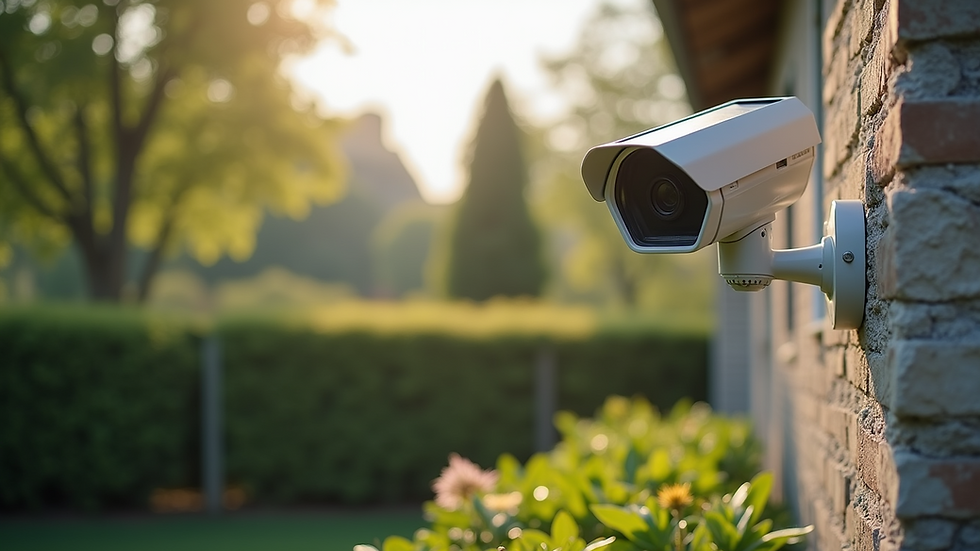Maximizing Efficiency: Tips for Solar Powering Your Wireless Outdoor Security Cameras
- Sheldon M

- Sep 20
- 4 min read
In today's world, ensuring security for your home or business is crucial. Outdoor security cameras have become vital tools, providing peace of mind to property owners. However, maintaining power for these cameras can be challenging, especially in remote areas where access to electricity is limited. Solar power emerges as a practical and sustainable solution. It not only keeps your cameras operational but also helps you save on energy costs. In this post, we’ll walk through how to solar power your wireless outdoor security cameras effectively, letting you enjoy uninterrupted security.
Understanding Solar Power for Security Cameras
Solar power captures energy from sunlight and converts it into electricity using solar panels. This renewable source is highly suitable for outdoor security cameras, as it eliminates complex wiring and significantly reduces reliance on conventional power sources.
By harnessing solar energy, you safeguard your cameras against power outages and maintain functionality in areas with little to no electricity. Plus, this green option can lead to notable savings—homeowners can save up to 50% on their energy bills over time.
Choosing the Right Solar Panel
Selecting the right solar panel is crucial for effectively powering your security cameras. Here are key factors to consider:
Wattage: Choose a solar panel with the correct wattage to meet your camera's needs. Most wireless cameras require anywhere from 5 to 20 watts, depending on features and usage. For example, a camera with night vision may need more power.
Size: Larger solar panels can capture more sunlight, increasing efficiency. However, they require adequate installation space. A standard residential solar panel is usually around 65 inches by 39 inches.
Durability: Opt for panels specifically designed for outdoor use. These panels should withstand harsh weather conditions, such as rain, snow, and extreme heat.
Compatibility: Ensure the solar panel is compatible with your camera model. Some brands design panels that work seamlessly with their systems, enhancing performance.

Installation Tips for Solar Panels
Once you've selected the right solar panel, follow these tips for a successful installation:
Location: Place the solar panel in a spot that gets maximum sunlight daily. Avoid shaded areas caused by trees or buildings.
Angle: Tilt the panel to maximize sunlight exposure—ideally at a 30-degree angle, which is often effective.
Mounting: Use durable mounting brackets to secure the solar panel. Make sure it is tightly fixed to withstand strong winds. For example, in areas with high wind speeds, consider using extra fixtures.
Wiring: Connect the solar panel to your camera per the manufacturer's instructions. Ensure all connections are robust and weatherproof to avoid issues.
Battery Storage Solutions
While solar panels generate energy during the day, your security cameras also need power at night. Battery storage is essential. Here’s what to keep in mind:
Battery Type: Lithium-ion batteries are popular for their efficiency and longevity. They can often store enough energy for a camera to operate overnight and during cloudy days.
Capacity: Pick a battery that meets your camera's power needs. Assess how many hours you require it to operate and choose a battery that provides that energy, often around 10,000 mAh for most small outdoor cameras.
Charging: Guarantee that the solar panel can sufficiently charge the battery. Regularly monitor battery levels to ensure everything is functioning well.

Regular Maintenance for Solar-Powered Security Cameras
To keep your solar-powered security cameras running smoothly, consistent maintenance is necessary. Here are some actionable tips:
Clean the Solar Panel: Dust and dirt can block sunlight, reducing the panel's efficiency. Clean it periodically with a soft cloth and mild soap to maintain optimal performance.
Inspect Connections: Regularly check the wiring and connections between the solar panel and camera. Look for signs of damage and replace faulty components promptly.
Monitor Battery Health: Watch the battery's performance closely. If you notice a drop-off in power or charging efficiency, consider replacing the battery.
Software Updates: Ensure your camera's firmware is current. Manufacturers often provide updates that enhance performance and security.
Advantages of Solar-Powered Security Cameras
Solar-powered security cameras come with numerous benefits:
Cost-Effective: The initial setup cost might be higher, but solar power can lead to significant long-term savings on electricity bills—by up to 50%.
Eco-Friendly: Using renewable energy decreases your carbon footprint and contributes to a more sustainable future. Studies show that solar installations cut carbon emissions by more than 80% compared to traditional power sources.
Flexibility: Solar-powered cameras can be installed anywhere without the need for electrical outlets. This flexibility allows placement in remote areas for improved security coverage.
Reliability: When installed correctly, a solar panel and battery system can ensure your cameras stay operational during power failures.
Why You Should Consider Solar Power for Security Cameras
Solar power provides a smart way to maintain your camera setup efficiently and sustainably. By selecting the right solar panel, ensuring proper installation, and maintaining your system regularly, you can achieve consistent and reliable security.
As advancements in technology continue, solar-powered cameras will likely become even more efficient and accessible. Opting for this eco-friendly solution not only secures your property but also contributes to a greener planet.





Comments